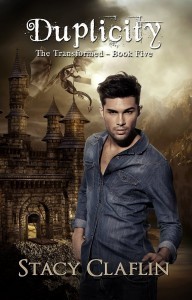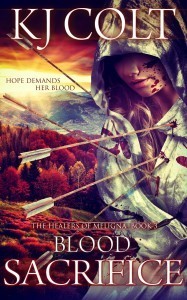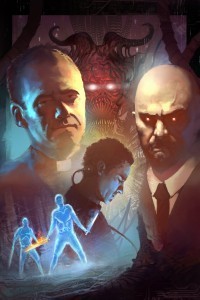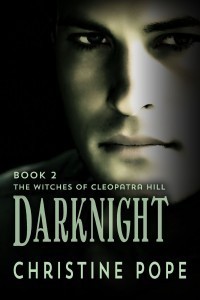Cora Buhlert's Blog, page 117
July 9, 2014
Mansplaining and Amazon Bashing at Klagenfurt – The Annual Bachmann Prize Post
This year’s Ingeborg Bachmann Prize was somewhat more low-key than usual, probably because everybody’s attention is engaged by the World Cup and it was a hot and tiring weekend in general. For more about the competition read this, this and this post from previous years.
I almost forgot that the Bachmann Prize was on, so I missed the first day, including the eventual winner Tex Rubinowitz and his story Wir waren niemals hier (We were never here), and only heard a few of the texts and subsequent discussions. My general impression, albeit based on a small sample size, was that this year’s crop of Bachmann Prize texts was rather mediocre to underwhelming. It’s an impression largely shared by German speaking critics and cultural journalists. For an example, see this write-up in the Swiss paper Neue Zürcher Zeitung.
Echoing the NZZ write-up, there were pleasantly few texts this year about dealing with WWII/the Third Reich/Communist East Germany, which was a surprise, since three of the last four winners were texts dealing with these subjects (and two of them weren’t even particularly good). One of the texts I did manage to listen to, Millefleurs by Austrian writer Georg Petz, did touch on the current “rememberance mania” and the excessive celebration of the anniversaries of D-Day and the beginning of WWI, the manner of which Petz’s protagonist finds as distasteful as I do, but it does so in the context of a contemporary love triangle between a German exchange student, a French woman and her French boyfriend.
With fewer texts focussing on “our sorry history”, the majority of the texts instead focussed on the other big Bachmann Prize topic, the ennui of modern life, described in exhaustive detail. And so we got stories about conflicts between parents and grown children, stories about broken relationships and memories of past romances, stories about death and suicide, stories about drugs, stories about battling with bureaucracy. I’m not sure if those texts are necessarily better than the “our sorry history” stories, but at least they are stories about the way we live now and not about something that happened decades before the contestants were even born, filtered through second and third hand family anecdotes.
There is an element of public performance to the Bachmann Prize, as the statues require a public reading by the author in addition to the submitted texts. Indeed, the reading is such an important component of the competition that this year author Karen Köhler was disqualified, since she was unable to attend due to an accute case of chickenpox. And because the reading is so important, the author’s performance sometimes seemed to overshadow the actual content of the text.
This was very notable with regards to the discussion about the entries by the two Swiss contestants, where the jurors debated more about the performance than about the actual texts. The debate about Michael Fehr’s text Simeliberg, which I quite liked, focussed almost entirely on Fehr’s performance (Fehr refused to sit, but walked around, reciting his text as dictated by his iPod) as well as on his Swiss accent. Now Swiss German can be nigh incomprehensible to the Non-Swiss, but Fehr’s accent was perfectly comprehensible (and actually quite endearing). Immediately afterwards, Swiss writer Ramona Ganzoni, who is a native speaker of Romansh by the way, was accused by head juror Burkhard Spinnen of having “read her text to death”. By this point, I was beginning to wonder what the jurors had against the Swiss. Or maybe they had a problem with regional themes, since both texts were very Swiss IMO.
We also got some prime examples of mansplaining, mostly at the hands of the above mentioned head juror Burkhard Spinnen who didn’t want to see so many stories about mother/daughter conflicts and also couldn’t understand why Bruna, the protagonist of Ramona Ganzoni’s text Ignis Cool was suffering from low self-esteem, at which point I yelled at the TV, “Dude, if you were a woman you’d know.” City-born Spinnen also claimed to know more about cows than Ms. Ganzoni, completely disregarding the fact that Westfalian cows may behave quite differently from Swiss cows. Come to think of it, Spinnen also engaged in mansplaining last year, when he believed that a story about a woman finally finding the strength to break up with her jerky boyfriend was too hard on the boyfriend.
But the mansplaining and Swiss bashing at the Bachmann Prize were nothing against the Amazon bashing. The cultural program kulturzeit devoted more of its Bachmann Prize coverage to discussing Amazon than to discussing the actual competition. See this interview with Sandra Kegel, who is one of the jurors,, wherein Ms. Kegel spends more time complaining about Amazon and e-books than actually talking about the competition and the contestants. Moneyshot: Ms. Kegel laments that Amazon does not nurture and challenge writers like the traditional publishers do, while totally disregarding the fact that those self-publishing via Amazon mostly aren’t exactly keen on the sort of “nurturing and challenging” provided by traditional publishers.
There was also an interview with an Austrian independent bookseller complaining about Amazon as well as Austrian TV journalist Ernst A. Grandits (whom I normally quite like) calling e-books “a threat to literature”. Thankfully, several people disagreed with him and pointed out that e-books are books. Nonetheless, I was tempted to add “Destroying literature since 2011″ to my Pegasus Pulp tagline.
Now the event is called “Tage der deutschsprachigen Literatur”, i.e. “Days of German Language Literature”, so e-books and Amazon’s influence on German language literature are legitimate topics for discussion, especially given the current uproar about Amazon’s contract negotiations with Hachette in the US and Bonnier in Europe. Nonetheless, it is first and foremost a writing competition and I fail to see what Amazon has to do with that. Even if Amazon’s market share and indie publishing in general grows further, there’ll always be Bachmann Prize contestants, even if they may choose to indie publish their text later on. As for e-books destroying literature, I spotted a Kindle at the Bachmann Prize, used in lieu of a manuscript, two years ago and somehow the competition and German language literature managed to survive.
Finally, I’ll leave you with this delightful Bachmann bingo, courtesy of the Austrian radio station ORF 4.
 Send to Kindle
Send to Kindle
July 8, 2014
What a Match!
I’m normally not the world’s biggest football fan. Oh, I like football all right and I’m happy when our local first league team Werder Bremen wins (which sadly hasn’t been all that many times these past few years). But mostly it’s enough for me to know the result afterwards – I don’t actually have to watch the match live.
World Cups normally interest me even less than regular league games, because our national team is usually made up from a lot of players from clubs I couldn’t care less about and about half of them are Bayern Munich players at any given time. And Werder Bremen supporters normally don’t much like Bayern Munich, because the two clubs are archrivals.
However, yesterday’s World Cup semi-final, where Germany beat Brazil 7:1, was the big exception, since it was the best football match I’ve seen in a long time and a damn entertaining ninety minutes of TV in general.
I hadn’t actually planned to watch the whole match, since I was rather tired last night. Plus, I’d had a service tech at my home all afternoon long, repairing a leaky ACU. Besides – as I said – mostly knowing the result is enough for me.
I watched at my parents’. That is, my Mom and I watched on the first floor, while my Dad was in the basement catching up with some paperwork. When the first goal happened, approx. 11 minutes in, I went down the two flights of stairs into the basement to tell my Dad. A few minutes later, the second goal happened (scored by former Werder Bremen player Miroslav Klose, who is now the top World Cup scorer of all time with 16 goals altogether). So I went down the two flights of stairs again to tell my Dad and hadn’t even made it back up, when I heard my Mom cheering. “Don’t tell me they just scored another?”, I asked disbelievingly.
About two minutes later I had to go down to the basement yet again to report on goal No. 4. By the time goal No. 5 happened, my Dad had finally made it up to the TV room.
When the half time whistle sounded, I could have gone home, because it was pretty clear that Germany was going to win that match. But though I was still tired, I stuck around and watched Germany score two more goals and finally Brazil scoring their “goal of honour” in the last two minutes. All of which was fantastically entertaining, though I felt a bit sorry for the Brazilian players and fans, many of whom were openly crying. In fact, by the last two goals several Brazilian fans actually started clapping for Germany, which was really nice.
Also nice was watching German players comforting Brazilian players – often players who play in the same teams in the regular league games and thus know each other – after the game. At one point, several German Bayern Munich players were comforting Dante, a Brazilian playing for Bayern Munich.
No matter what happens in the final, this was one hell of a match. And it happened almost to the day sixty years after the so-called “miracle of Berne”, when Germany beat Hungary in the 1954 World Cup final (apparently Hungary were a contender back then) and also almost to the day forty years after Germany beat the Netherlands in the 1974 World Cup final. They took the cup once more, in 1990, which is the only German World Cup win I can actually remember, even though I was theoretically alive for the 1974 win.
Driving home, I was a bit surprised to hear quiet and sad music on the radio, because this was so not a night for quiet music. There still was very little traffic, though I did hear some fireworks and a few car horns (common in big cities, but not in the semi-rural suburb where I live).
Back home, I watched the late night news and logged onto the Internet. I saw a few stupid Nazi jokes/remarks on Twitter, which were not just not funny but also totally uncalled for, and actually unfollowed one guy over those tweets.
There also were some people complaining about people daring to watch and enjoy something as trivial as a football match and the news programmes devoting time to football coverage, when there is a massive crisis going on in the Middle East and another in Ukraine. Now I’m not a big fan of extensive sport coverage to the detriment of other news, but this was an exception. Never mind that both the half-time news and the late night news did cover the situation in Israel/Gaza and Ukraine. And expecting people not to watch a major sports event and celebrate a win is just contrary to human nature, especially since there is always something horrible happening somewhere in the world.
That said, missile shrapnel hitting the German cruise liner Aida Diva off the Israeli coast is not the most important bit of news about the situation in Israel/Gaza, even if some news programs tried to spin it that way.
 Send to Kindle
Send to Kindle
July 5, 2014
Linkdump, mostly about indie publishing, SF and climate issues
Over at the Pegasus Pulp blog, I look back on three years of indie publishing and share some metrics. I’ve also got another post listing research resources I used for the Silencer series and New York City’s Finest.
Forbes has a very good article from David Vinjamuri about how indie and maker movements are changing commerce in a variety of fields. When I started self-publishing three years ago, I used to post links to a lot of articles about indie publishing. I’ve largely stopped doing that, because the articles all started to sound the same after a while and the tone became increasingly strident, such as the whole “us vs. them” mentality displayed in the commentary about the current Amazon vs. Hachette conflict. However, I really like this Forbes article, because it looks at indie and DIY movements in a variety of fields such as music, gaming, crafts, film, etc… and doesn’t just focus on publishing.
Regarding the Amazon vs. Hachette conflict, I really like John Scalzi’s rather measured take on the subject, wherein he points out that both Amazon and Hachette are businesses focussed on their own interests and not anybody’s friend. Of course, the more enthusiastic fringe of indie writers begged to disagree, but then they always do.
The winners of the 2014 Locus Awards have been announced and again the slate looks pretty good. I’m particularly happy to see more love for Ancillary Justice.
A blog called Armed and Dangerous (name says it all) offers its definition of “real SF”, i.e. the sort of thing Heinlein used to write and John C. Campbell used to publish in Astounding (found via SF Signal). Anything else is “defective SF, non-SF or anti-SF”. Characterisation? We don’t need no stinking characterisation. It reads very much like yet another example of people yelling at clouds that SF has changed, while the rest of us are over here, doing our own thing.
Arisia Crystal has a helpful post explaining exactly how to vote on future Worldcon locations. Alas, it seems I cannot vote on the 2017 location with my Loncon membership, though I can vote on the 2016 location which is a choice between Beijing and Kansas City.
Spiegel Online has a fascinating article about how a monster drought and record heatwave hit Europe in 1540, resulting in a massive catastrophe and some excellent wine. The article is only available in German, but Pierre Gosselin offers a summary at No Tricks Zone. Australian SFF writer Patty Jansen weighs in as well and points out that weather conditions like in 1540 are quite normal for Australia, but devastating for Europe and even more so in pre-modern times.
The Virtuelles Literaturhaus Bremen profiles my pal Axel Knapp, literary translator and owner of the small press Mocambo Verlag, and recommends Poste restante – Postlagernd, a memoir by Hubert Kerdellant about working in the French and German postal service, translated into German by Axel Knapp.
 Send to Kindle
Send to Kindle
July 2, 2014
New historical romance short available: Hanging Day
July 3rd (i.e. tomorrow) marks my three year indie publishing anniversary. I’ll do a more detailed post with some sales statistics over at the Pegasus Pulp site tomorrow, but for now I’ve got a new release to announce just in time for the anniversary.
Hanging Day marks a return to the “historical romance with a bite” (and some blood and guts) subgenre to which some of my most popular stories belong. This one has it all, a dashing highwayman, an innocent maiden in danger and the seedier side of 18th century London as a background.
I’ve also got several new sales channels, including plenty of Italian stores, to announce (read this post at the Pegasus Pulp blog or simply peruse the complete list of retailers). In the near future (i.e. going through editing, proofing and formatting now) there will also be a new Shattered Empire story as well as a new Silencer adventure.
But for now, travel back in time to Georgian London where public executions were popular entertainment:
Hanging Day London, 1751: It’s hanging day at Tyburn and nine condemned criminals, six men and three women, are about to meet their end on the infamous triple tree. Among the crowd come to see them hang is Jack Blackstone, better known as Blackjack the highwayman.
London, 1751: It’s hanging day at Tyburn and nine condemned criminals, six men and three women, are about to meet their end on the infamous triple tree. Among the crowd come to see them hang is Jack Blackstone, better known as Blackjack the highwayman.
But Jack has not come to Tyburn on this day merely to gawk at the spectacle of a public execution. For among those to be hanged today is Eliza Colson, Jack’s beloved, sentenced to death for a crime she did not commit.
Jack is going to save her from the gallows… or die trying.
For more information, visit the Hanging Day page.
Buy it for the low price of 0.99 USD, EUR or GBP at Amazon US, Amazon UK, Amazon Germany, Amazon France, Amazon Spain, Amazon Italy, Amazon Canada, Amazon Australia, Amazon Brazil, Amazon Japan, Amazon India, Amazon Mexico, Kobo, Barnes & Noble, Apple iTunes, Casa del Libro, Scribd, Inktera, txtr, Thalia, Weltbild, Hugendubel, Der Club, Libiro, Nook UK, DriveThruFiction, OmniLit/AllRomance e-books, Flipkart, e-Sentral, You Heart Books and XinXii.
 Send to Kindle
Send to Kindle
June 29, 2014
Indie Speculative Fiction of the Month: June 2014
 It’s that time of the month again, time for “Indie Speculative Fiction of the Month”.
It’s that time of the month again, time for “Indie Speculative Fiction of the Month”.
So what is “Indie Speculative Fiction of the Month”? It’s a round-up of speculative fiction by indie authors newly published this month, though some May books I missed the last time around snuck in as well. The books are arranged in alphabetical order by author. So far, most links only go to Amazon.com, though I may add other retailers for future editions.
This is the biggest indie speculative fiction round-up to date, featuring 29 SF, fantasy and horror books. Again, we have a broad spectrum of titles, featuring space opera, epic fantasy, Steampunk, Chinese historical fantasy, Norse mythology, dystopian fiction, bizarro fiction, urban fantasy, vampires (Stuart, Icelandic and celebrity), witches, necromancers, fantasy romance, YA fantasy, zombies, the afterlife, techno exorcists, Romans in space, deadly plagues, science fiction romance, short story collections and much more.
As always, I know the authors at least vaguely, but I haven’t read all of the books, so Caveat emptor.
If you’re looking for more indie speculative fiction, check out the Speculative Fiction Showcase, a new blog devoted to all things indie speculative fiction.
And now on to the books:
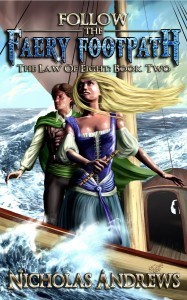 Follow the Faery Footpath by Nicholas Andrews
Follow the Faery Footpath by Nicholas Andrews
When the Thrillseekers reunited, they did not know the treasure they sought was the first marker of the Faery Footpath, a journey which would lead them to a godstone… one half of magic’s last earthly legacy. With Len-Ahl the Stonechaser leading the way, they seek the second marker within the iconic tomb of an ancient king. For with the Elemental Stone, they can put an end to the ambitions of Queen Qabala, as well as the evil power she serves.
However, Qabala has not been idle. Even as her forces prepare for war with the east, the holder of the world’s other remaining godstone trails after Nerris and his companions. Her allies are not only human, but from beyond the world as well. A ferocious dragon is spotted in the Tormalian skies, and a deadly beast known as the Malkind awakens from its ancient imprisonment.
The Thrillseekers must also contend with internal struggles as new faces join their journey, and unscrupulous agents seek to destabilize the alliance of the eastern kingdoms. Nerris and Len-Ahl find they must hold true to their quest, and to each other, as the fight for the fate of the world draws near.
This is the sequel to Secrets of the Stonechaser.
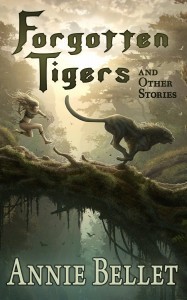 Forgotten Tigers and Other Stories by Annie Bellet
Forgotten Tigers and Other Stories by Annie Bellet
From a grim near future to ghostly forests on far flung planets, from lost loves to magic gone awry, this collection of ten short stories brings you fully imagined tales of science fiction and fantasy.
Forgotten Tigers & Other Stories contains seven brand new and three previously published stories.
Includes the stories “Forgotten Tigers”, “The Crimson Rice Job”, “Innocence, Rearranged”, “Falls the Shadow on Broken Stone”, “Singing Each to Each”, “Nos Morituri Te Salutamus”, “Somebody Else’s Problem”, “Ghosts in the Mist”, “Infinitesimal Mercies” and “FUBAR”
Yin Lihua will to pay heaven’s price to save everything she loves in this historical fantasy short story….
In the age of China’s Three Kingdoms, great forces fight over the corpse of the Han Empire. Among the leaders that emerge from the chaos, the Duke of Shan and the King of Tian stand apart. They are no ordinary Chinese noblemen. They are vampires, and with their armies, they vie for ultimate control of the Central Kingdom.
Lady Yin is the Duke of Shan’s consort, bound to him eternally, heart, mind, and body. The mother of his heir, she will do anything to keep her lord and her child from falling into the hands of the enemy.
Anything at all.
Heaven’s Price contains explicit sexual content and is not intended for minors. It is not a romance. Fans of Chinese historical drama will find this story both interesting and refreshing.
Brenton is the town with no shadow, or the town where no one dies. When a budding necromancer inherits an old house, a grimoire, and a familiar, in the form of a crow the town starts to see a lot of strange happenings.Toss in a demon named Cain with his own agenda and an unlikely ally in the form of a preacher and you may have a recipe for disaster. Zane wants to use his black magic to keep people in town from passing on, but will it all catch up to him in the end?
Grimoire is a monthly serial. Each installment between 12,000 and 20,000 words. The books are meant to be read in order, but they are all their own story. If you’re not familiar with serials you can think of them like television shows for books!
Alrekur Vidarsson had to wait three thousand years to finally fall in love. He spent two thousand years searching for her, but then she found him, awaking him from death.
Unfortunately, she was engaged to another, and Alrekur had to wait another eighty years. Finally, he won her over and they got their happily ever after…except that it won’t be that easy.
The birth of their daughter has awakened the entire dragon species, who had been sleeping since before Alrekur was born. The dragons have their sights set on Alrekur’s family, and they’ll stop at nothing to get what they want, not caring if they destroy everyone he loves in the process.
With the threat of the Queens’ army increasing, only blood healing can save South Senya. Adenine continues her journey alone, encountering constant danger and tragic loss. Clutching at the strands of her sanity, Adenine barely makes it to Juxon City where the king proves untrustworthy and hostile.
The Queens quickly destroy all Adenine’s hope for the kingdom of Senya. Under their rule, the people are doomed. She has allies, but they are too few to take back the city. The only one who can challenge the Queens is the emperor of Bivinia: a monster responsible for the deaths of hundreds of healers. She must convince him to invade Senya, replacing one evil for another.
This is the third book in the Healers of Meligna series, following Concealed Power and Blood Healing.
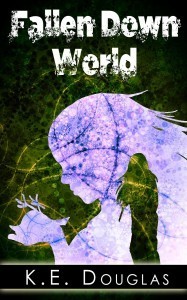 Fallen Down World by K.E. Douglas
Fallen Down World by K.E. Douglas
Florida was supposed to be all sunny beaches and Disney World, the perfect vacation. Instead, fifteen-year-old Dani is the only member of her family not struck with a ferocious new flu. Now the only part of Florida she cares about is the road out. Home is what her family needs, but home is a thousand miles away.
Dani’s family aren’t the only ones who are sick. The hospitals and highways are littered with the dead and dying. Dani is soon adrift in a world where she struggles to find food and fuel as she tries to get her family home. In this terrifying new world, every stranger is a threat and each mile is a battle.
But home isn’t the salvation Dani hopes for. Now, she needs to survive in a world that will never be the same.
 Benton: A Zombie Novel by Jolie du Pré
Benton: A Zombie Novel by Jolie du Pré
Zombies have killed everyone in the Benton household–all except twenty-something Jennifer. She’s escaped her bedroom, but what now? Waterbank, Illinois is overrun. Where can she go?
A chance encounter with seven other young survivors points her toward Texas. A charismatic, handsome young man named Mark says he can lead them all to his family’s ranch. He’s sure they’ll be safe there. Jennifer wants to trust him, with her life and possibly her heart.
There’s no place else to go, there’s no way to escape the zombies but through, and there’s no telling if Jennifer and Mark will live long enough to act on the emotion building between them.
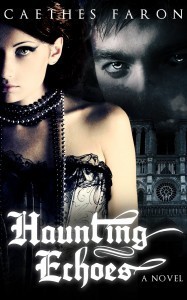 Haunting Echoes by Caethes Faron
Haunting Echoes by Caethes Faron
Amaia was one of the most sought after courtesans in King James’s London when she became a vampire. Together with her sire, Lawrence, she works to birth a new, more powerful race of vampires. She has everything she could want: wealth, prestige, and eternal life.
She fears nothing. That is, until Michael, the first man she killed, walks into a tavern twenty-three years after she killed him. He has more reason than most to hate her; he’s the man who gave her the engagement ring she still wears. She’s convinced he’s come back from the grave for one purpose: to destroy her.
Michael’s gray eyes haunt Amaia until she surrenders and goes to him. If her clan finds out about her obsession, they’ll kill her and him. But if she stays away, she’ll go mad. Both paths lead to destruction, and it’s up to Amaia to find a way to keep herself and Michael alive, whether Michael still loves her or not.
Dante Butcher is a twenty-four-year-old programmer living alone in Los Angeles. At least, that’s the part of him people see. He doesn’t tell them he dreams of the Dead Side: a skewed land of past and present inhabited by shades.
Dreams are one thing, but matters are complicated when the dead don’t agree to stay that way. Shades like to drink and smoke and revel in the pleasures of the flesh. They cling to the physical world, but they can’t stand here on their own. They need to attach to something tangible. Usually that means other people.
Possession. It is a means for the dead to hide in plain sight. But Dante Butcher is more than he appears as well. He can see them. The shades. The fakers. And he’s not at all alone either. He’s haunted by the ghost of a murdered little girl who may end up being his only ally. Yet, as Dante gets more involved with the machinations of the dead, he learns one important truth: you can’t trust shades.
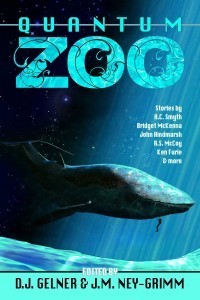 Quantum Zoo, edited by D.J. Gelner and J.M. Ney-Grimm
Quantum Zoo, edited by D.J. Gelner and J.M. Ney-Grimm
From a ghost park to a time-travel penitentiary of murderers to a menagerie of Egyptian deities, Quantum Zoo presents 12 compelling stories involving 12 very different living exhibitions. Includes stories by D.J. Gelner, Sarah Stegall, A.C. Smyth, S.E. Batt, Ken Furie, Scott Dyson, John Hindmarsh, Morgan Johnson, R.S. McCoy, Frances Stewart, J.M. Ney-Grimm as well as Hugo and Nebula nominee Bridget McKenna.
It’s only been a few days since Veterinarian Amy Lewis escaped Asgard with the FBI’s professional hacker, Bohdi Patel. The escape involved “borrowing” Odin’s magical, world-walking, eight-legged, horse, Sleipnir. Now Odin wants Sleipnir back. FBI Director Steve Rogers doesn’t want Odin getting anything he wants. Amy and Bohdi want to set Sleipnir free. The horse has his own ideas. A story (mostly) from Sleipnir’s point of smell.
 Reckless Recon by Rinelle Grey
Reckless Recon by Rinelle Grey
Following his brother half way across the galaxy seemed like a good idea at the time, but it hadn’t hit him just how much he was giving up. Stir-crazy after three weeks in space, Kerit, professional surfer turned interstellar colonist, jumps at the chance to get off the ship and onto the new planet’s surface—even if it is a little inhospitable.
He expects searing heat. He expects acid rain. He even expects the sunburn from hell. What he doesn’t expect is to meet Folly—the most prickly, irritating, and fascinating girl he’s ever known. And he needs her help if they want to make this planet their new home.
Determined to find her father’s ship and prove he was a brilliant scientist, Folly has no interest in getting to know Kerit. The cute stranger is just a distraction. Unless of course he can help her in her search…
But something sinister lurks in the ruined city, and neither of them realise how much they are going to have to rely on each other if they want to make it out alive.
Reckless Recon is the third book in the Barren Planet Romance series, following Reckless Rescue and Reckless Rebellion.
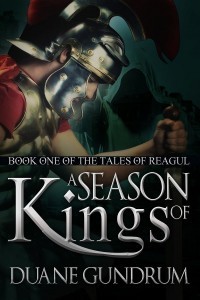 A Season of Kings by Duane Gundrum
A Season of Kings by Duane Gundrum
The Tales of Reagul is the story of the sorcerer Sarbonn who is chosen by the “gods” to act as their representative and the planet’s protector.
During the dawn of the Roman Empire, a segment of the population is transplanted onto another planet as part of an alien sociological experiment. This planet, Reagul, develops a new history as its people slowly begin to realize they will never return home again.
Sarbonn, gifted with the science of the aliens (“the gods”), discovers they have been abandoned by the aliens, leaving them to forge their own destiny in a lonely corner of the stars.
The first book involves their colonization of this new world, their struggles with survival, greed and the realization that they are not alone. Previous civilizations have been transplanted to this planet before them. And Sarbonn discovers he’s not the first sorcerer, and that the previous ones may not be all that welcoming to the new inhabitants.
 Bound in Blue by Heather Hamilton-Senter
Bound in Blue by Heather Hamilton-Senter
Gods walk among us—all you have to do is See.
High school senior Rhiannon Lynne couldn’t get noticed even if she walked stark naked into the cafeteria and started playing the banjo. While tap dancing. As if that weren’t strange enough, Rhi has synesthesia—she feels in color. It takes being almost drowned by a Celtic river goddess for her to discover she’s been bound by a spell that has hidden her from the world and her own mysterious heritage.
As Rhi starts to see that her colors belong to magic, she finds herself at the center of a conflict between gods, humans, and the lost world of Avalon. She’ll need to figure things out fast if she wants to be a player in the coming conflict and not a pawn. Each side has a claim on her loyalty, but each one could decide she’s the real threat.
Hopelessly attracted to a god of thunder; deeply connected to a boy with no memory of his past; irresistibly drawn to a creature with a taste for flesh—Rhi’s choices could decide the fate of worlds, but their choices could decide hers.
Maybe not being seen wasn’t so bad after all.
In the near future, a man climbs the corporate ladder inside a powerful company but finds that with each promotion he must sacrifice a part of himself. (6500 words, approx. 23 pages)
Salvatore Antonelli, a disgraced ex-bishop, and Benito Castillo, a young tech-priest fresh out of Seminary, are tasked by the Vatican to confront DAMON-1, a nuclear capable AI that claims to be Satan incarnate, returned to the physical world to bring about Armageddon.
The two clergy must battle to restore DAMON and purge Satan from the enslaved AI’s core. The bishop is forced to play a deadly game with billions of lives in the balance, while the young priest must confront Satan’s digital persona within the network.
The eternal conflict between good and evil, fought in the space between time, brings humanity and their AI creations to the dawn of a new age, and to the brink of annihilation.
“The Exorcist” meets “Skynet” meets “The Matrix” in this thought-provoking new science fiction thriller.
 The Inventor’s Son by S.B. James
The Inventor’s Son by S.B. James
Set in a Victorian London that could have been, The Inventor’s Son is the story of twelve year old Ethan Stanwood, whose father is a reclusive and brilliant inventor and scientist. Sickly and isolated, Ethan’s entire world revolves around his father and his work. He believes that this is all his life has to offer him, in spite of the latent magical talents he’d inherited from his mother that are beginning to surface.
When his father abruptly flees London one Monday morning, Ethan’s quiet life is swiftly turned into a fight for his survival. His father tasks him with bringing their most important prototype back to him, and has only left vague clues for Ethan to follow in order to find him. While Ethan has to try and find his father, he must also face his father’s foes who will stop at nothing to get Ethan and the prototype.
Ethan thinks he knows everything there is to know about his father. He is about to find out how very wrong he is.
Georgette
Pulitzer Prize-winning journalist Georgette McClain can’t resist a juicy tip. So when a rumored crazy ex-CEO gifts her evidence of a vast conspiracy involving the world’s premier scientific community, Arcadian Heights, she sets her sights on the story of a lifetime. And all she has to do to grab it by the reins is sneak into the most secure facility in the world—and expose it for the slaughter house it is.
Marco
Tech company CEO Marco Salt has it all. Fame. Fortune. Family. But not long after Marco’s beloved genius daughter is invited to join Arcadian Heights, a rogue agent reveals to him the horrifying truth about the revered scientific community. Forced to flee for his life, Marco finds himself on the run with a deadly secret in his grasp and a single goal in mind: destroy Arcadian Heights.
Quentin
Quentin Belmont has been the Arcadian Heights spokesman for the better part of two decades, and his singular motivation is to keep the community safe at all costs. So when an internal incursion leaks vital information to an outside party, Quentin preps a “cleanup” without a second thought. But what at first appears to be a simple task turns out to be anything but, and Quentin comes face to face with the unthinkable—a threat that could annihilate the community.
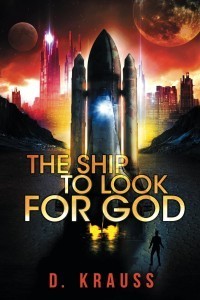 The Ship to Look for God by D. Krauss
The Ship to Look for God by D. Krauss
Otto Boteman suffers a massive heart attack and wakes up in a strange, jeweled city filled with beautiful people, a mesmerizing sky defying all physics, and what looks suspiciously like his first car. Seeking answers, Otto has a disturbing encounter with a murdered childhood friend and is assured by some kind of angel bureaucrat that this is Heaven, but God is not here so don’t bother looking. No God? Can’t be Heaven, then, despite the best danishes he’s ever eaten and residence in a pretty nice condo (replete with tailored suits and HBO). Maybe he’s not even dead, just comatose. But then he meets Claudia, a 5th Century beauty running an Irish pub, who tells him about a group of malcontents building a rocket ship in the far desert. Their mission? Find God.
So begins Otto’s journey across a fabulous world peopled with the likes of Doc Holliday, Prester John, and a Mongol horde led by an accountant from West Kankakee, Illinois. Drawing the wrath of a frenzied, suit-wearing army of angels (or demons, can’t tell), Otto discovers that launching the ship just might end the eternal struggle between good and evil.
 Dead South Rising by Sean Robert Lang
Dead South Rising by Sean Robert Lang
Welcome to the South, where the dead are dangerous, and the living are deadly.
David didn’t know he killed another man’s wife. He was only trying to save his own family. His friends. Himself.
And now he’s being hunted. By the dead. And by the living. He thinks he can handle the dead. But can he handle the living?
Book 1 of the Dead South Saga, a zombie drama/thriller. Contains strong language and violence.
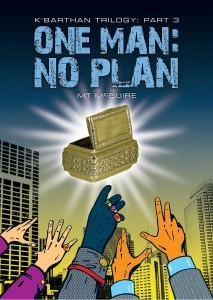 One Man, No Plan by M.T. McGuire
One Man, No Plan by M.T. McGuire
Confused ex-outlaw, pardoned for all misdemeanours, seeks answers…
The Pan of Hamgee has a chance to go straight, but it’s been so long that he’s almost forgotten how. Bewilderingly, despite a death warrant over his head he is released, given a state-sponsored business, and a year’s amnesty from all offences while he adjusts.
He doesn’t have a year, though. In only five days Lord Vernon will gain total power and destroy K’Barth. Much to his frustration, the only person who can avert it is The Pan: a man without a plan.
This book is the third in a series, following Few Are Chosen and The Wrong Stuff
 A Play for the Castle by Zelah Meyer
A Play for the Castle by Zelah Meyer
Arthur and his friends are noblemen disguised as traveling players. Raising an army in secret, while dodging mercenaries and cabbages alike, isn’t easy. Neither is keeping secrets from the curious young woman he happens to be falling in love with. She thinks he’s just an actor with a shady past, and if he’s to have any hope of a future, he can’t put her right. Between sword fights and scene changes, life is about to get interesting.
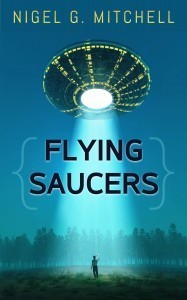 Flying Saucers by Nigel G. Mitchell
Flying Saucers by Nigel G. Mitchell
As a recent graduate of the University of Destruction and Mayhem, Mortog Flethrax is eager to make his mark in the Xenon Empire that rules the Galaxy. Mortog’s first assignment is an insignificant little planet so pathetic that even its inhabitants call it dirt: Earth. With his devoted robot soldiers and textbook from class, Mortog plans to rule the world in less than twenty-four hours. He’s starting with the town of Dead Meat.
Jeffrey Foster has spent his entire life in the tiny town of Dead Meat, Illinois. He’s always thought small, been afraid to take chances. His life’s ambition is to get promoted to assistant manager at the convenience store where he works. All that is about to change when Mortog Flethrax comes to Earth.
When it turns out that Jeffrey’s best friend Dirk is a highly trained intergalactic freedom fighter, Jeffrey will be forced to rise up and save the world.
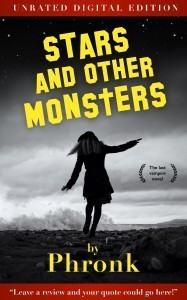 Stars and Other Monsters by Phronk
Stars and Other Monsters by Phronk
Stan Lightfoot is the perfect paparazzo. His dog, Bloody, can track down anybody, anywhere, which comes in handy whenever a celebrity involved in a juicy scandal tries to avoid public attention. He’s about to get the perfect picture—a real privacy-invading winner—when he runs into a vampire who ruins his life.
From the dark and vulgar mind of Phronk — author of Baboon Fart Story — splashes a neo-vampire trip through nightmare America, full of movie stars and other soulless creatures, mind-numbing romantic comedies, and a Wal-Mart in every town.
When the vampire reveals a celebrity crush of her own, Stan finds a way to keep her from eating him. Helping a murderous monster screw a movie star wasn’t exactly what Stan had in mind when he got into photography, but it’ll buy him a few days. Can he find a way to escape a creature with god-like power before she reaches her destination?
Probably not.
Kidnapped by a rival witch clan, Angela McAllister envisions a dark future for herself until she discovers her captor’s brother is the unknown man who has haunted her dreams since she was a child. Forced to re-evaluate everything she’s ever known about the Wilcox witches, Angela begins to explore the powerful connection that binds her to Connor Wilcox, despite the generations of hostility between their families and the disapproval of those closest to her. And when a dark, malignant force arises, Angela knows she must draw on her growing powers as prima to protect enemies and allies alike…even if her choice threatens to tear her new and fragile love apart.
Darknight is the second book in the Witches of Cleopatra Hill, a paranormal romance trilogy set in the haunted town of Jerome, Arizona.
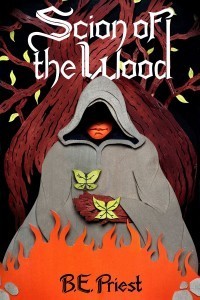 Scion of the Woods by B.E. Priest
Scion of the Woods by B.E. Priest
SIX MONTHS LATER
A monster is loose in the Trees’ Wood,
and the rebellion is suddenly revealed.
As Galen’s dark past comes to light,
war breaks out in the Queendom,
and Asher must choose a path,
risking all that he holds dear.
Sequel to Southwind Knights and The Queen of Grass and Trees.
Living with a gear heart made from magic and machinery, Auden knows his lifespan will be shortened. Now a second-class citizen, he’s part of the household of Dr. Gregory—the man who stitched him back to life years ago during the war. And now Dr. Gregory is being threatened.
A friendly (sometimes too friendly) police officer named Owen is assigned to help protect the aging doctor. Auden could resent the policeman who’s come to help with security. Instead, he finds himself drawn to the attractive, flirtatious Owen, who somehow doesn’t let Auden’s cold nature scare him away. And that holds a different kind of danger for Auden’s heart.
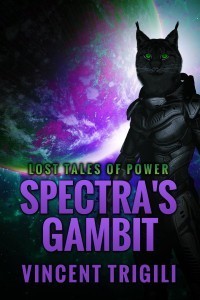 Spectra’s Gambit by Vincent Trigilli
Spectra’s Gambit by Vincent Trigilli
An old ally of Grandmaster Vydor comes to him for help because an enemy, perhaps as old as the Empire itself, has turned its sights on his Cathratinairian race and means to wipe them out. Spectra and Dusty are sent to find and stop this new threat, while Spectra begins her plan to change the balance of power for the entire known multiverse. Dusty must decide to follow Spectra as she uses this mission of mercy for her own gain, or stand with the Wizards Kingdom, which could put him in direct opposition to his wife.
The Lost Tales of Power is an open-ended series of Science-Fantasy books set in a vast multiverse. Spectra’s Gambit is the sixth book set in the Lost Tales universe
 Send to Kindle
Send to Kindle
June 26, 2014
“Not your typical suburban wife and mother”
First of all, my post about the latest review debate got linked on Metafilter. Some good discussion over there, too.
Then, Riverfront News, a St. Louis based newspaper, published this extensive profile of Nebula and Clarke Award winner Ann Leckie, which also goes quite a bit into the racism and sexism debate currently going on in the SFF genre.
It’s a very good and thorough article, with a few caveats. For example, does the colour of Ann Leckie’s toenail polish really matter? Or why is she introduced as “not a typical suburban mother of two” (not typical because of her choice of toenail polish) in the very first paragraph? And given that the article extensively goes into the debate over the SFWA Bulletin and the controversy regarding the Resnick/Malzberg column which focussed more on how Beatrice Mahaffey looked in a bikini than on her work, it’s surprising that the author doesn’t notice the irony of focussing on Ann Leckie’s choice of toenail polish.
Sadly, an extensive focus on appearance, maternal and marital status is typical for articles about women writers and indeed any women who archived anything ever. It’s almost a standard script by now: “She was just a typical suburban wife and mother until she wrote this book which happened to become a huge success.” Hence, E.L. James, who is a TV producer in her day job, is recast as a typical suburban wife and mother who would never dream of doing the sort of things she described in Fifty Shades of Grey in real life. Indie romance writer Colleen Hoover is a “married mother of three young boys living in rural East Texas and working 11-hour days as a social worker” who never even thought about writing before penning her bestselling novel Slammed. And Amanda Hocking, who is neither married nor a mother, still gets a condescending New York Times profile, which focusses more on her choice in clothing and furniture than on her novels.
At least the Riverfront News article acknowledges that Ann Leckie has been writing for years, collecting rejections and publication credits (though True Confessions does not publish bodicerippers – sigh) and taking writing classes, including attending Clarion. A lot of articles about women writers don’t seem to acknowledge the fact that writing takes practice and work at all and instead spin the story of the regular suburban wife and mother who just sat down one day to write a bestseller. See the well publicised story about Stephenie Meyer who supposedly had a dream one night and wrote Twilight without ever having as much as written a word before, even though we know that she took writing classes with Dave Farland.
It’s not just women writers either who are treated that way by the media, but women period: Check out this article about Dorothy Crowfoot Hodgkin, winner of the 1964 Nobel Prize for Chemistry. She just won the freaking Nobel Prize and yet she’s still “a British wife and mother of three”.
 Send to Kindle
Send to Kindle
June 21, 2014
Matchday Linkdump
I actually did watch tonight’s Germany vs. Ghana World Cup match – the interesting part of it at any rate. I missed the first twenty minutes or so. Afterwards, I watched Fantasia, which just happened to be on TV tonight.
One thing I noticed – aside from how fabulous Fantasia still looks 74 years after its first release – is that Fantasia is basically an attempt to convey what visual music synaesthesia feels like. Now I’m heavily music synaesthetic, so the film speaks to me. The person I was watching with is not music synaesthetic at all and has little affinity for music in general, so the movie didn’t work nearly as well for them. In fact, I suspect they would have preferred watching NCIS reruns.
But that’s all the football and Disney cartoons for today, so let’s have some other links, mostly about gender and SFF, because that’s one debate that never dies:
Ann Leckie has an interesting post about swearing and power differentials and what it says about power regarding who is allowed to swear in front of whom. Now I swear quite a lot and with impunity, as do my characters. And yes, there are people who don’t like that. Though interestingly, the people who are most likely to be upset by me swearing are older women.
Kari Sperring has a great post about living as a woman in a science fiction future and how problematic it is never to see yourself reflected in SF books, films, TV shows, etc… I share her sentiments in many ways, especially since I was also initially drawn to SFF, because it offered better roles for women than the mainstream stuff of the same era, only to end up feeling betrayed by the sexism inherent in much of the genre.
Not that everybody disliked the inherent sexism in the genre. In fact, Sandra Newman laments that science fiction isn’t as gonzo, bizarre and sexist anymore as it used to be in the good old days of Philip K. Dick and Cordwainer Smith at The Guardian. Now I’m not at all sad that the sexism and creepiness in the genre has declined somewhat, but if sexist, bizarre and offensive SFF is what Ms. Newman wants, we might have a few tips for her.
Jenny Gadget wonders why female readers and reviewers are expected to put up with books by (male) authors containing all sorts of sexist and blatantly offensive content, while male readers and reviewers whine that it’s so much work to find books by women. The post is a response to this post by debut SF writer Jon Wallace talking about writing “real women” who just happen to be sexbots (no joke) and this debate at Tor.com where some male book bloggers and reviewers go on about how hard it is to find books by women, when publishers mainly send them books by men and they’d rather read books by men, too. Now I have zero problems finding interesting books by women to read, especially since a lot of the dude-written and dude-focussed stuff doesn’t appeal to me. Writers of colour and QILTBAG writers require somewhat more effort, but again it’s not that difficult, if you’re willing to do the work.
Regarding Barricade by Jon Wallace, the SF novel with real women sexbots (at least the cover is sexbot free, unlike the monstrosity Tor forced on Charles Stross’ entry into the sexbot subgenre), the SFF genre’s resident curmudgeon Christopher Priest thoroughly savaged it in this review at Arcfinity, the harshness of which angered quite a lot of people. Meanwhile, Damien Walter believes that the genre needs more cruel and nasty reviews.
Now I’m not sure if the genre needs more nasty reviews and I haven’t read Barricade, nor am I likely to, but as I’ve pointed out before (also in response to a debate involving Christopher Priest coincidentally), Germany has something of a tradition of harsh and snarky reviews. The late Marcel Reich-Ranicki regularly served up much harsher fare than Priest, while German critic Denis Scheck once called a book “a literary abortion”, so I’m used to “reviewing as performance art”. Besides, it’s not as if US/UK genre critics are always gentle. For example, John Clute had very harsh things to say about one of Carrie Vaughn’s Kitty Norville stories in this 2011 review at Strange Horizons. Oddly enough, there was little to no outrage on behalf of Carrie Vaughn, probably because she’s a woman writing urban fantasy and not a guy writing about sexbots and climate change.
Finally, here is the best headline ever: Firefighters rescue man from stone vagina in Tübingen. The gist of the story is that a guy tried to crawl into a sculture depicting a giant vagina and managed to get stuck, so firefighters had to free him.
ETA: There’s also an English language article about the incident available at SMH Australia as well as at Huffington Post UK. Well, that headline is irresistable.
Finally, enjoy these photos of flowers in my garden:

Orange lillies in my garden

I’m not sure what these colourful flowers are called, but they’re sure pretty.
 Send to Kindle
Send to Kindle
June 20, 2014
New German crime short available – Neuer Kurzkrimi auf Deutsch erhältlich: Familienkutsche
It’s once again time for some announcements. First of all, my e-books are now available at the subscription e-book service Scribd as well as at You Heart Books, a new e-book store.
What is more, I have a new e-book available, namely the German translation of my second ever published story, the crime short Family Car.
***
Es ist mal wieder Zeit für ein paar Ankündigungen in eigener Sache. Zunächst einmal sind meine e-Books jetzt auch erhältlich bei Scribd, einem e-Book Abo Dienst, und You Heart Books, einem neuen e-Book Händler, welcher zur Zeit allerdings nur englische e-Books vertreibt.
Außerdem habe ich wieder ein neues e-Book anzukündigen. Diesmal handelt es sich wieder mal um einen Kurzkrimi und zwar nicht nur um irgendeinen Kurzkrimi, sondern um die deutsche Fassung der zweiten Kurzgeschichte, die ich je veröffentlicht habe.
Familienkutsche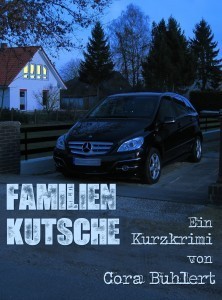 Alex durfte zwar den Minivan behalten, aber er verlor die Familie, für die er die Kiste gekauft hatte, seine Frau Helen und seine kleine Tochter Sandy. Aber obwohl Alex Helen schon lange nicht mehr liebt, wenn er sie denn je geliebt hat, wird er niemals seine Tochter aufgeben. Und Mord ist manchmal eben eine billigere Lösung als eine Scheidung…
Alex durfte zwar den Minivan behalten, aber er verlor die Familie, für die er die Kiste gekauft hatte, seine Frau Helen und seine kleine Tochter Sandy. Aber obwohl Alex Helen schon lange nicht mehr liebt, wenn er sie denn je geliebt hat, wird er niemals seine Tochter aufgeben. Und Mord ist manchmal eben eine billigere Lösung als eine Scheidung…
Für mehr Infos, besuchen Sie bitte die Familienkutsche Seite.
Erhältlich für den günstigen Preis von 0,99 EUR, USD oder GBP bei Amazon Deutschland, Amazon USA, Amazon UK, Amazon Frankreich, Amazon Italien, Amazon Spanien, Amazon Canada, Amazon Australien, Amazon Brasilien, Amazon Mexico, Amazon Japan, Amazon Indien, Kobo, Apple iTunes, Thalia, Weltbild, Hugendubel, Der Club, BOL, Otto-Media, Donauland, buecher.de, Barnes & Noble, Scribd, Bild eBooks, Casa del Libro, e-Sentral und XinXii.
Dieses Buch gibt es auch auf English.
 Send to Kindle
Send to Kindle
June 15, 2014
Mid June Linkdump
At Slate, M.R. Carey gets into the neverending literary versus genre fiction debate, belatedly responding to the attacks on genre fiction by Arthur Krystal (see my posts here and here) and Edward Docx (see my post here).
At Bookworm Blues, Jamie Lee Moyer writes about women characters in her own work and how depressing it is that one still needs to point out strong and well realized women in novels, films, etc…, because there are still way too many that treat women only as walk-on characters. Indeed, “there are no women in this” is pretty much an instant dealbreaker for me in anything longer than a short story. It’s also troubling how many works there are, several of them acknowledged classics, that can’t even muster a single female character. And no, it’s set during a war/on a ship/on a space ship is not an excuse.
Juliet McKenna wonders whether it’s time for a women’s speculative fiction prize to raise the profile of female speculative fiction writers, since books by women are still less reviewed and less promoted, particularly in UK bookstores. The inspiration for the post for the all-male shortlist for this year’s David Gemmell Award, which is nominated and decided by popular vote. In case you wonder you won, Emperor of Thorns by Mark Lawrence won in the best novel category and Promise of Blood by Brian McClellan in the best debut category. Pornokitsch also offers their take on all the finalists.
I must confess, I never bother with nominated or voting for the Gemmell Awards, because I don’t read a whole lot of epic fantasy and the books that tend to end up on the shortlist are so not my thing. Maybe I should, if only to provide a counterpoint to the grimdarkness and blokes in cloaks that dominate this award.
At The Daily Dot, Gavia Baker-Whitelaw points out that the protagonists of upcoming videogames all look remarkably similar, namely they’re all angry, unshaven white guys. Which is highly problematic, sincer gamers are somewhat more demographically varied than angry white men. And what’s with the lack of shaving anyway? Are unshaven videogame characters supposed to show off animation detail? Which makes the whole “women are difficult to animate” uproar surrounding the latest Assassin’s Creed game seem even more like a sad excuse.
At The Guardian, Jessica Valenti theorizes whether the relative scarcity of rape scenes might be the reason why The Walking Dead is so successful with women. Now I’m on record as not liking The Walking Dead at all. I don’t care for zombie stories in general and The Walking Dead is not even a particularly good or original example of a zombie tale or at least it wasn’t when I still watched it (up to the end of season 2, though I missed a few episodes in the middle). I also found the show extremely problematic on the race and gender front and I do recall at least one rape/high dubious consent sex scene, but maybe it has gotten better since then.
Also at The Guardian, Nicholas Barber wonders whether the upcoming Guardians of the Galaxy movie heralds a come back for the space opera genre on the big screen. I can only hope so, since I like space opera a lot (hell, I even write it) and the Guardians of the Galaxy trailer look like a lot of fun, especially considering that my initial reaction to the announcement was “They’re filming what?” Even my Mom was impressed when she chanced to see the Guardians of the Galaxy trailer on my laptop recently. That is, she was quite enchanted by Rocket Raccoon.
Nicholas Barber also offers an interesting theory why there was so very little space opera available in the past ten to fifteen years and why what little there was often so violent and depressing. Now I’m not a fan at all of blaming every social or cultural trend of the past 13 years on the “war on terror”, especially since the “war on terror” has never been such a big deal here as it is in the US/UK. But in this case, Barber’s theory makes sense, since space opera is a generally optimistic genre that is as much about exploring and encountering the other as it is about colonising and killing them. And it is notable that post-2000, space-based filmic SF mostly turned into more or less thinly veiled analogies on the “war on terror” such as the new Battlestar Galactica or the crappy later seasons of Enterprise (Deep Space 9 was also a notable offender and largely predates the “war on terror”), while literary space opera was mostly confined to the “rah, rah, space marines” stuff that is the bread and butter of Baen Books. And if like me you don’t happen to overly care for Earth-based marines, let alone space-based ones, there was something of a dearth of good space opera. Luckily, you could still find space opera in the science fiction romance subgenre and indie publishing has also given the space opera subgenre a boon, even though a lot of indie space opera seems to be yet more of the “rah, rah, space marines” type (because apparently there isn’t enough of that stuff around already). However, last year has seen the publication of two high profile space operas that don’t fit the “rah, rah, space marines” stereotype with Ann Leckie’s Ancillary Justice and Rachel Bach’s Paradox series.
The Cover Café has released the results of their annual romance cover contest and this time around my votes even match the majority opinion in all but one category. This hit rate is unprecedented, since my tastes in cover design very rarely match those of the majority of romance readers.
 Send to Kindle
Send to Kindle
June 10, 2014
Of Penny Dreadfuls and Moral Panics
The Guardian has an article about the so-called penny dreadfuls, cheap serialized novels of the Victorian era, inspired by the success of the eponymous TV series (which I haven’t yet seen, hence no comment).
I usually don’t remember where and how I first came across a particular term, but “penny dreadful” is an exception here, because I know exactly how and where I first heard or rather read the term “penny dreadful”. It was sometime in the late 1980s in the Rotterdam branch of De Slegte, a Dutch-Belgian bookstore chain, which offered a mad mix of used and new books, usually remainders. I hung out at De Slegte a lot, because no one bothered you in the labyrinthine interior (except for boys who occasionally tried to hit on me – utterly without success, because I never understood what they wanted of me). My favourites were the comic book section (my Dutch was good enough for comics, but not for novels), the art/design section (who cares what language it’s in) and the movie/TV/media section, where most of the books were in English. It was in this section or rather on the opposite side of the shelf to where I had retreated to escape a lanky youth who seemed uncommonly interested in the backissues of Starlog magazine that I really wanted to look at. And that’s where I came across a large coffee table type book on penny dreadfuls with lots of full colour reproductions of covers (it was probably this book, since the release date fits). And though I had never heard the term “penny dreadful” before, I immediately knew what it was. For I was only too familiar with the German term “Groschenheft” used for a similar form of popular literature, that was often derided as trash. Calling that sort of thing “penny dreadful” was absolutely perfect. Over the next few days I looked through the book several times (as I said I hung out at De Slegte a lot), admired the penny dreadful covers and the tantalizing thrills promised by the titles. I never bought it though, one of my great regrets along with that Encyclopedia of Superheroes I once found at De Slegte and didn’t buy either.
What I found fascinating about the Guardian article is that penny dreadfuls quickly found themselves at the centre of a moral panic (the Daily Mail was of course involved) just like their German cousins the “Groschenheft”. Even the examples given for how penny dreadfuls supposedly corrupted youth are eerily similar to examples given by anti-”Groschenheft” campaigners in Germany. For all of a sudden, every crime or better yet suicide (since suicide victims cannot refute any stupid theories about why they did it) committed by a young person was believed to have been caused by penny dreadfuls. Evidence: the young criminal or suicide was found to have owned and read penny dreadfuls.
The so-called “Schundkämpfer” (anti-trash crusaders) in Germany used very similar examples of crimes and suicides supposedly inspired by reading “Groschenhefte”. One example that always stuck with me was that of a teenaged cabin boy who vanished from a ship en route from Hamburg to New York in the early years of the 20th century. The boy had apparently gone overboard, but it was never even determined whether it was an accident or suicide or even murder. However, several “Groschenhefte” were found in the boy’s cabin, so the culprit was clear, at least as far as the media was concerned. The “Groschenhefte” has inspired the boy to jump overboard. Of course, there was absolutely no evidence, but then a good moral panic doesn’t need evidence.
Unfortunately, I can’t find any detailed info about the cabin boy case on the net, but here is a similar but later example, that of 17-year-old Manfred who lived near Hannover and committed suicide in 1963 by drinking pesticide. Manfred left a suicide note by talking onto an 8-track tape until he died and for some reason, the weekly newspaper Die Zeit decided to print excerpts of Manfred’s suicide tape. It’s a touching document, in which Manfred speaks freely about his problems with his parents, particularly his father, and the neighbours he regarded as surrogate parents. Honestly, after reading this article I just wanted to reach out through time and give Manfred a hug. However, Manfred also read “Groschenhefte” and liked watching westerns and crime movies at the cinema, so guess where Die Zeit sees the causes for his suicide? Yup, blame the “Groschenhefte” and western movies. Because it can’t possibly be the family’s fault. Never mind that if you do the math and calculate when Manfred was born and when he was conceived, you’ll arrive at a much more convincing theory why Manfred didn’t get along with his parents and why he eventually killed himself. But we can’t possibly talk about that, can we? So let’s blame the media Manfred was consuming.
Stories like this aren’t rare, in fact they’re the standard building blocks of moral panics. What makes Manfred’s story unusual is that Die Zeit actually printed lengthy excerpts from Manfred’s suicide tape, which completely refute the theory that reading too many “Romanhefte” and watching too many bad westerns and crime movies drove Manfred to suicide.
But then actual data only gets in the way of a good moral panic and so conclusions are often made up, as the example of Fredric Wertham and the war on comics in the 1950s shows.
I have compared the explosion of indie publishing in the past few years to the rise of the dime novel or penny dreadful in the 19th and later the rise of pulp fiction in the early 20th century before (see here, here and here). In all cases, technological innovation led to the increased production and publication of fiction led to more readers, often people who didn’t read much before, which in turn leads to a moral panic about what those readers are reading. And indeed indie publishing is even doing the penny dreadful one better, since it isn’t just creating new dime and pulp novels, but it is also bringing the old ones back into print as this project to digitally reprint Victorian penny dreadfuls shows.
So if indie publishing is the new penny dreadful or the new pulp fiction, then where is the moral panic? As it is, we already had an indie e-book related moral panic last fall, when Kobo and W.H. Smith pulled all indie titles from their online stores (W.H. Smith never put them back either), because some moralistic busybodies, including of course the inevitable Daily Mail (Why don’t they just rename themselves “Moral panics R Us” and be done with it?), freaked out at some of the more out there erotica titles on offer (see my blog posts here and here).
What always strikes me about moral panics of any kind is not just how absolutely over-the-top and transparently false the allegations usually are (Honestly, why do people keep falling for this shit?), but also how similar the language used is. The media the campaigner doesn’t like is always referred to as “filth” or “trash” or “depraved”. If you’re German, use the term “Schund”. If you’re German and writing post-1945, make sure to mention something about “fascist aesthetics” or “fascist tendencies”, whereby a character with blonde hair and blue eyes is enough to make a work suspicious of “fascist tendencies” (bonus points if the character in question is actually dark-haired). I’ve heard Germans accusing even Captain America of fascist tendencies, because Steve Rogers happens to be blonde and blue-eyed. Just insert your favourite “Steve Rogers crying” gif right here.
Finally, I want to leave you with this infuriating post on digital culture blog run by the public TV station ZDF, wherein the author laments about self-published e-books sold for one Euro and how this trash is taking over the bestseller lists. The headline: “E-Schund: Kampf um den 1-Euro Leser”
 Send to Kindle
Send to Kindle
Cora Buhlert's Blog
- Cora Buhlert's profile
- 14 followers




